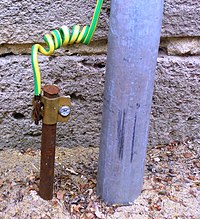
Photo from wikipedia
Fault detection in resonant grounding (RG) distribution networks remains a challenge due to weak fault signals, extremely complex fault conditions, and unstable intermittent arc grounding faults. This paper addresses this… Click to show full abstract
Fault detection in resonant grounding (RG) distribution networks remains a challenge due to weak fault signals, extremely complex fault conditions, and unstable intermittent arc grounding faults. This paper addresses this issue by applying generalized S-transform (GST) with a variable factor to conduct denoising of transient zero-sequence currents based on threshold filtering followed by time-frequency distribution filtering in sequence. Meanwhile, this paper proposes a comprehensive multi-criteria faulty feeder detection method based on the transient zero-sequence current polarity (criterion 1), the energy relative entropy (criterion 2), and the total transient current energy (criterion 3). Here, criteria 2 and 3 are based on the time-frequency representation of the GST. The performances of the proposed denoising and faulty feeder detection methods are evaluated under single line to ground faults based on simulations conducted using a modeled 10 kV RG networks with overhead and cable mixed lines in addition to reasonably sophisticated permanent and intermittent arc discharge models to ensure that the simulations faithfully represent actual complex working conditions. Compared with existing method, simulation experiments and field test show that the method proposed in this paper provide a better denoising effect with stronger self-adaptability, higher detection accuracy, and a faster calculation speed.
Journal Title: IEEE Access
Year Published: 2020
Link to full text (if available)
Share on Social Media: Sign Up to like & get
recommendations!